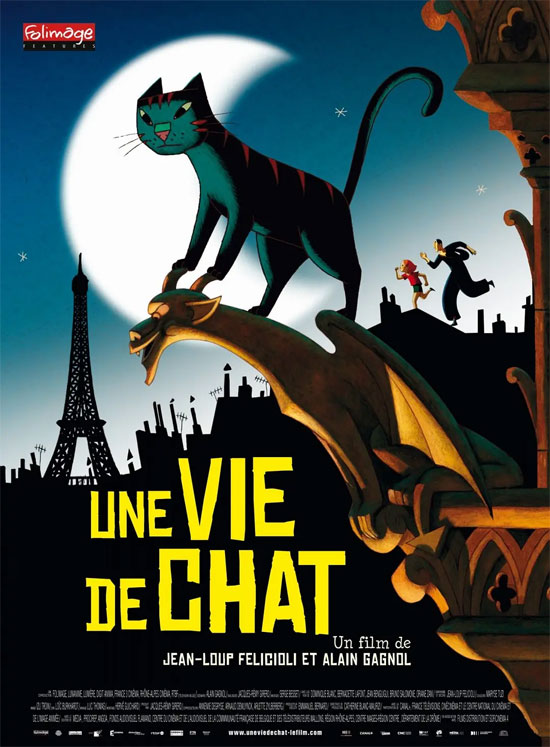Film Name: 猫在巴黎 / A Cat in Paris

This film once again proves beyond doubt a fact that has been demonstrated countless times: an outstanding animated film requires neither photorealistic 3D characters nor glasses-enhanced 3D effects. What it truly needs is a captivating story, relatable characters, and an artistic style that never grows tiresome.
While we complain that the Oscars consistently crown 3D blockbusters as winners each year—as if viewing all animations through 3D-tinted glasses—we must also quietly thank the Academy voters. At least they manage to select one or two such unconventional 2D animations for us nearly every year. And from “Les Triplettes de Belleville” to “L’Illusionniste,” we’ve come to understand the voters’ tastes—they have a particular fondness for French animation.
“A Cat in Paris” tells the story of two felines: one a genuine black cat, the other a “cat burglar.” While ‘thief’ is often colloquially called “fur thief” in Chinese, the English term “cat burglar” refers to those possessing specialized skills in theft. The cat burglar favors dark attire matching the black cat’s coat, moving with feline agility as he leaps across rafters. This undoubtedly deepens the metaphor of anthropomorphizing cats. Yet the two cats’ greatest difference lies in their lives: the black cat has an owner and a home, while the cat burglar is solitary, finding joy solely in theft.
The black cat in the film embodies a dual identity: by day, it lazily curls up beside its young human mistress, appearing both indolent and timid; yet at night, it seeks out its other master, the cat burglar. Its eyes gleam with intensity, its tail stands proudly erect, and its agile form darts and weaves with remarkable agility. This contrast is starkly evident—from being bullied by the nanny in the little girl’s home to prowling atop high walls at night, looking down with disdain at the barking dogs in the neighboring yard.
The little girl is also a lonely soul. Since her father’s death, she has stopped speaking. She has only her mother, a police officer who constantly struggles to balance work and family without success. Her mother is relentlessly pursuing the killer who shot her husband. Of course, there is also the nanny. Early on, a glance from the nanny as she leaves hints that she is far from ordinary.
The story should have unfolded between the little girl, her mother, and the evil murderer, but the black cat’s dual identity draws the “cat thief” into the mix. In fact, the most ingenious aspect of the entire film is how it weaves the “cat thief” into the little girl’s family in a way that is both bizarre and seamless.
Of course, we all know how things turn out when a man suddenly enters the life of a single-parent family. Yet we still marvel at how a skilled and seasoned director and screenwriter can craft such a predictable story into something that still moves us. The only way is to spare no effort in exploring the depths of human nature. I believe no one can remain unmoved when the little girl watches her mother’s car drive away, murmuring “Mom” softly.
Though much of this film unfolds under the cover of night, the radiance of humanity shines through every frame, illuminating both the story and the hearts of its audience. The “Cat Thief,” despite his criminal nature, extends a helping hand to a stranger’s little girl—a gesture revealing a deeper, hidden pursuit of meaning within his own life. Every viewer can empathize with the mother’s struggles. Though she strives to balance family and work, she often fails to manage both well. Yet she never ceases to give her utmost effort. When the demonic visage of her husband’s killer first flashes through her mind, she breaks down under the pressure. But when she confronts that monstrous image a second time, she finds the courage to face it head-on. Courage and compassion—she is a truly great mother!
The black cat bridges two lonely souls: the little girl and the “cat thief.” These two isolated individuals support each other: the cat thief opens the girl’s closed heart, while the girl helps the cat thief find meaning in life. Both simultaneously became sources of strength for the mother’s courage, vividly showcasing women’s unique familial dependence and affection. Just as the black cat had its own home, every character in the film needed a family for support. Even cats need a home.
Stylistically, this film brims with quintessential French romanticism. Amidst tense plotlines, humorous visuals abound, and the fluid narrative teems with intricate details. The opening and closing montages of the “cat thief” dashing across rooftops—one accompanied by a cat, the other carrying a little girl—are particularly captivating. Personally, I believe the segment featuring line animation in complete darkness pushes the expressive potential and charm of animation to its peak, making it arguably the film’s most brilliant sequence.
PS: The film’s only regret is the underdeveloped personalities of several supporting characters. The henchmen under the gang boss feel indistinguishable in both physique and traits, yet this isn’t a work with the strong symbolism seen in “Les triplettes de Belleville.” After watching, many characters left a strong impression on me, yet I felt no sense of presence from those henchmen. Another minor flaw is that the film feels a bit too short. But that’s just a minor quibble.
Please specify:Anime Phone Cases » A Cat in Paris 2010 Film Review: Every cat needs a home